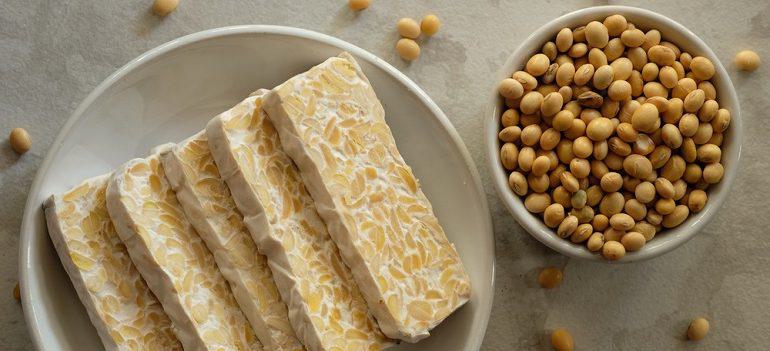


 The method of making tempeh is valued as more of a tradition than a process. Tempehs unparalleled flavor and nutrients are produced through the process of fermentation. Like tofu, tempeh is made from soybeans and sometimes with brown rice. However, the process of making it is entirely different. To make tempeh, soybeans are first washed and brought to a boil. They are then soaked overnight, hulled, and cooked for about an hour before being drained and cooled. After cooling, the soybeans are mixed with a particular type of fungus that begins the fermentation process.
They are then wrapped in banana leaves (or plastic bags) and fermented for 24-48 hours. The soybeans bind together with the fungus during the fermentation process to transform the tempeh into a firm cake-like creation.
In most grocery stores, both fresh and pasteurized tempeh is available for purchase. Not sure what the difference is? Pasteurized tempeh is made by introducing the mixture to high levels of heat. Doing so stops the fermentation process and keeps it from spoiling too quickly. Fresh tempeh is tempeh that has not been introduced to high heat. Though the fresh ingredients contain a lot of flavor and nutrients, they will need to be enjoyed within 3-5 days, as they won't keep as long as the pasteurized variety.
The method of making tempeh is valued as more of a tradition than a process. Tempehs unparalleled flavor and nutrients are produced through the process of fermentation. Like tofu, tempeh is made from soybeans and sometimes with brown rice. However, the process of making it is entirely different. To make tempeh, soybeans are first washed and brought to a boil. They are then soaked overnight, hulled, and cooked for about an hour before being drained and cooled. After cooling, the soybeans are mixed with a particular type of fungus that begins the fermentation process.
They are then wrapped in banana leaves (or plastic bags) and fermented for 24-48 hours. The soybeans bind together with the fungus during the fermentation process to transform the tempeh into a firm cake-like creation.
In most grocery stores, both fresh and pasteurized tempeh is available for purchase. Not sure what the difference is? Pasteurized tempeh is made by introducing the mixture to high levels of heat. Doing so stops the fermentation process and keeps it from spoiling too quickly. Fresh tempeh is tempeh that has not been introduced to high heat. Though the fresh ingredients contain a lot of flavor and nutrients, they will need to be enjoyed within 3-5 days, as they won't keep as long as the pasteurized variety.
 Ready to start cooking tempeh? Tempeh can be prepared in several different ways depending on the requirements of your vegan tempeh recipe. Keep scrolling to discover the many ways you can begin cooking tempeh today!
Ready to start cooking tempeh? Tempeh can be prepared in several different ways depending on the requirements of your vegan tempeh recipe. Keep scrolling to discover the many ways you can begin cooking tempeh today!
 Whether you're switching to a plant-based diet or are simply searching for a new Meatless Monday recipe, tempeh is an excellent meat alternative. Before vegan and vegetarian diets became popular, finding a healthy meat alternative wasn't an easy task.
For centuries tempeh has been used in dishes as an alternative, healthy source of protein. It's made from whole grains and legumes, loaded with nutrients and fiber, and is relatively unprocessed. Additionally, it's much easier to digest because it's fermented, allowing your body to absorb those nutrients and antioxidants much more quickly. Enjoy tempeh as a primary source of protein, or add it to your dishes to make them a bit meatier.
Whether you're switching to a plant-based diet or are simply searching for a new Meatless Monday recipe, tempeh is an excellent meat alternative. Before vegan and vegetarian diets became popular, finding a healthy meat alternative wasn't an easy task.
For centuries tempeh has been used in dishes as an alternative, healthy source of protein. It's made from whole grains and legumes, loaded with nutrients and fiber, and is relatively unprocessed. Additionally, it's much easier to digest because it's fermented, allowing your body to absorb those nutrients and antioxidants much more quickly. Enjoy tempeh as a primary source of protein, or add it to your dishes to make them a bit meatier.